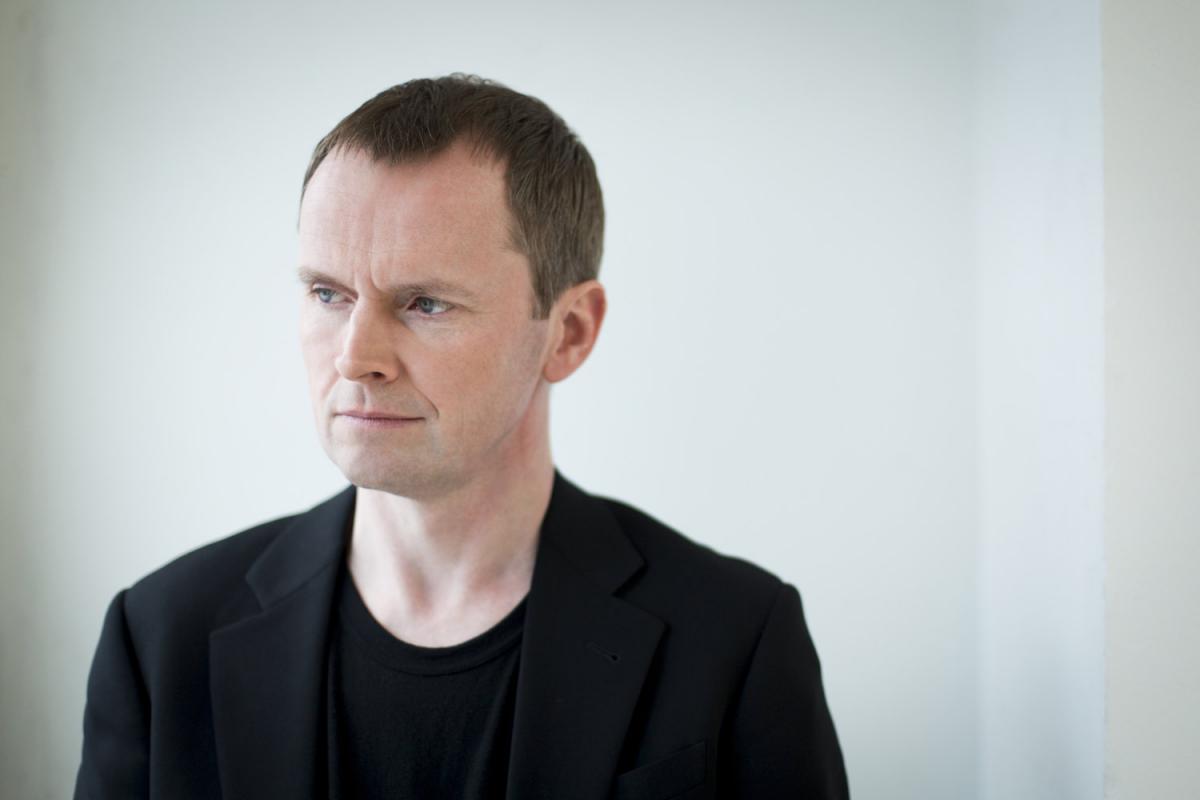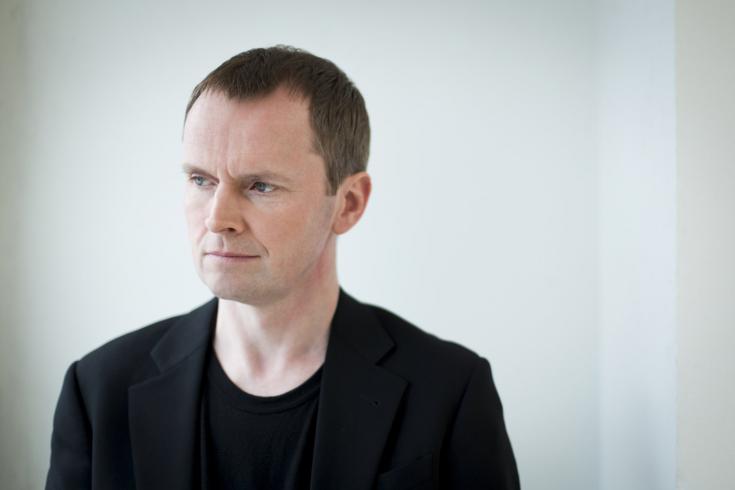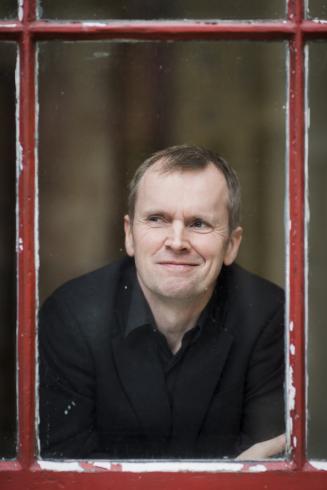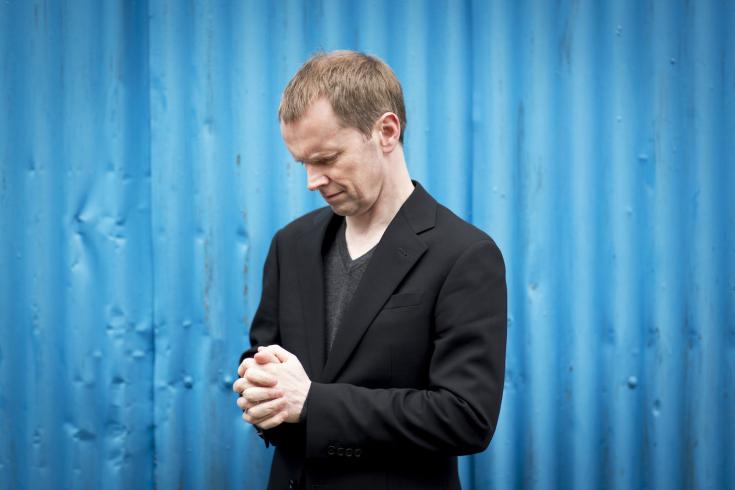Steven Osborne
Piano

Pianist Steven Osborne will make his Phillips Music return with a performance of Messiaen’s monumental cycle Vingt Regards su l’Enfant-Jésus.
Program
Born in Scotland in 1971, Steven Osborne is one of the finest pianists of his generation. Osborne performs a wide repertoire, with particular specializations in French, Russian, and British music. His spontaneity, technical brilliance, and spiritual depth are ideally matched to Messiaen’s monumental cycle Vingt Regards sur l’Enfant-Jésus, completed in 1944. Osborne’s acclaimed recording of the Vingt Regards was released in 2002, and he has since given hugely successful live performances of the cycle. A series of contemplations on the Christ child evoked in music of emotional power, the work was inspired by Messiaen’s deeply-held Catholic faith and is unquestionably one of the most original piano works of the 20th century. This will be Osborne’s third performance at the Phillips.
Please note that this concert’s duration is two hours without intermission.
PROGRAM:
OLIVIER MESSIAEN (1908-1992)
Vingt Regards sur l’Enfant Jésus (1944)
Regard du Père
Regard de l’étoile
L’échange
Regard de la Vierge
Regard du Fils sur le Fils
Par Lui tout a été fait
Regard de la Croix
Regard des hauteurs
Regard du temps
Regard de l’Esprit de joie
Première communion de la Vierge
La parole toute puissante
Noël
Regard des Anges
Le baiser de l’Enfant-Jésus
Regard des prophètes, des bergers et des Mages
Regard du silence
Regard de l’Onction terrible
Je dors, mais mon cœur veille
Regard de l’Église d’amour
Please note that this concert takes place at the Cosmos Club, 2121 Massachusetts Ave., NW.
About the Artist
Steven Osborne is one of Britain’s most notable musicians whose insightful and idiomatic interpretations of diverse repertoire show an immense musical depth. His numerous awards include The Royal Philharmonic Society Instrumentalist of the Year (2013) and two Gramophone Awards for recordings of Britten’s works for piano and orchestra and of solo works by Prokofiev and Mussorgsky.
Concerto performances take Osborne to major orchestras all over the world including recent visits to the Deutsches Sinfonieorchester Berlin, Salzburg Mozarteum, Oslo Philharmonic, Finnish Radio Symphony, Danish National Radio, London Symphony, Royal Stockholm Philharmonic, Yomiuri Nippon Symphony, Australian Chamber Orchestra, Aspen Music Festival, and Mostly Mozart Festival at Lincoln Center. He has enjoyed collaborations with conductors including Christoph von Dohnanyi, Alan Gilbert, Vladimir Ashkenazy, Stéphane Denève, Ludovic Morlot, Juanjo Mena, Leif Segerstam, Andrew Litton, Ingo Metzmacher, Vladimir Jurowski, Ed Gardner, and Jukka-Pekka Saraste.
He is a favorite soloist of British orchestras and for the 2016/2017 season is Artist in Residence with the City of Birmingham Symphony Orchestra. Reflecting his eclectic musical taste, Osborne brings concertos by Beethoven, Rachmaninov, Messiaen, Britten, and Tippett to Birmingham. He regularly works with the London Philharmonic, BBC Symphony, BBC Philharmonic and BBC Scottish Symphony Orchestra, with whom he recently completed a Beethoven Piano Concerto cycle, and last August made his thirteenth appearance at the Proms.
Osborne’s recitals of carefully crafted programs are publicly and critically acclaimed without exception. In recent seasons he has held residencies at both De Singel in Antwerp and at Wigmore Hall and has performed in many of the world’s prestigious venues including the Konzerthaus Vienna, Amsterdam Concertgebouw, Philharmonie Berlin, de Doelen Rotterdam, Palais des Beaux Arts Brussels, Suntory Hall Tokyo, the Kennedy Center, and Carnegie Hall. His chamber music partners include Alban Gerhardt, Paul Lewis, James Ehnes, Dietrich Henschel, and Alina Ibragimova.
Highlights of 2016/2017 season include performances with the Oslo Philharmonic, Tokyo Metropolitan Symphony, Dresden Philharmonic, Royal Flemish Philharmonic. St Louis Symphony, Oregon Symphony, Hallé, and BBC Symphony. Recital tours take him to Japan, Italy, Belgium, the US, and Wigmore Hall.
This past season welcomed the release of his 25th recording on the Hyperion label spanning an 18-year partnership. These releases accumulated numerous awards from the UK, France, Germany, and the US including two Gramophone Awards, three Preis der Deutschen Schallplattenkritik Awards, a Choc in Classica Magazine and many “Editor’s Choice” in Gramophone. His recordings span a wide range of repertoire including Beethoven, Schubert, Debussy, Ravel, Liszt, Stravinsky, Prokofiev, Rachmaninov, Medtner, Messiaen, Britten, Tippett, Crumb, and Feldman. His second recording of Beethoven sonatas, Opus numbers 90, 10, and 106 was released in October 2016 and his recording of the Ravel Piano Concertos coupled with de Falla Nights in the Gardens of Spain was released in spring 2017.
Osborne won first prize at the prestigious Clara Haskil Competition in 1991 and the Naumburg International Competition in 1997. Born in Scotland, he studied with Richard Beauchamp at St. Mary’s Music School in Edinburgh and Renna Kellaway at the Royal Northern College of Music in Manchester. He is a Visiting Professor at the Royal Academy of Music and was elected a Fellow of the Royal Society of Edinburgh in March 2014.
Notes
Olivier Messiaen, Vingt Regards sur l’Enfant-Jésus (1944)
Vingt Regards sur l’Enfant-Jésus (Twenty Gazes on the Infant Jesus) is one of the most grandly-conceived works in the entire piano literature. It was composed in Paris between March 23 and September 8, 1944—one of the most turbulent periods in modern French history. The final months of the Nazi Occupation of Paris saw a broken city on the brink of collapse. By mid-August the Allied armies were poised to enter the city and on August 15, resistance elements within the police went on strike, taking over the Préfecture at the Quai des Orfèvres and flying the French Tricolore in Paris for the first time in four years. On the evening of August 24, a few Allied tanks slipped into the city and parked in front of the Hôtel de Ville. The main Allied forces arrived the next morning and Paris was liberated on August 25, 1944. General de Gaulle led a triumphant parade from the Arc de Triomphe to Notre-Dame.
Messiaen’s Paris home at the time was in the 19th-arrondissement (in the northeast of the city), an area where French résistants had erected barricades in the streets (one such barricade, in nearby Belleville, was memorably photographed by Robert Doisneau). Surrounded by insurrection and chaos, Messiaen was only two weeks away from completing the Vingt Regards when Paris was liberated. It was his longest work to date and its music is utterly original in both sound and conception (though the composer admitted the influence on his piano writing of Liszt, Chopin, Albéniz, Debussy, and Ravel). Messiaen’s pocket diary for 1944 survives and though it makes no mention of the historic events unfolding at the time, it includes numerous references to the Vingt Regards and to a closely related project—twelve pieces (Douze Regards, as Messiaen called them) of incidental music for a radio broadcast, written to accompany poems by Maurice Toesca about the Nativity. On March 31, 1944, Messiaen noted that he needed to “prepare music for the Douze Regards,” an interesting reference given that he began composition of the Vingt Regards just a week earlier, on March 23.
By the end of August 1944, with composition of the cycle very close to completion, Messiaen began making arrangements for private performances of the Vingt Regards with Yvonne Loriod—his brilliant pupil who later became his second wife—played some of the pieces to groups of friends in September. Messiaen spent the end of September and the start of October making a few final adjustments to the work, and on October 14 he telephoned the conductor Roger Désormière to tell him that “my Vingt Regards are finished!” In November, Messiaen showed the Vingt Regards to Pierre Capdevielle (head of chamber music at French Radio), presumably to generate interest among broadcasters, and on December 15 he rehearsed the work with Yvonne Loriod. Four days later, on December 19 in the Salle du Conservatoire, Loriod gave the first public performance of two Regards (Regard de l’Esprit de joie and Le baiser de l’Enfant-Jésus).
The premiere of the complete work followed in March, 1945. Messiaen and Loriod were exceptionally busy at the end of that month, with concerts on three consecutive days: on March 24, at a concert of the Société Nationale de Musique, one of Loriod’s compositions was performed and Messiaen played songs by his first wife, Claire Delbos. The afternoon of March 25 saw Loriod and Messiaen at the Schola Cantorum playing Messiaen’s Visions de l’Amen and on Monday, March 26, at the Salle Gaveau, the premiere of Vingt Regards sur l’Enfant-Jésus was given by its dedicatee, Yvonne Loriod. On that occasion Messiaen gave a spoken introduction to each piece, and he also prepared a printed text given to members of the audience at the premiere:
Contemplation of the Christ Child of the manger and Gazes cast upon him: from the inexpressible Gaze of God the Father to the multiple Gaze of the Church of Love, passing through the incredible Gaze of the Spirit of Joy, the most tender Gaze of the Virgin, then those of the Angels, of the Magi, and of immaterial or symbolic creatures (Time, the Heights, Silence, the Star, the Cross).
The work uses several new types of musical language. Each piece is thus different from its neighbors in terms of style, but the same themes run from one end to the other of the Vingt Regards. It was written between March 23 and September 8, 1944.
I: Regard du Père (Gaze of the Father): And God said: “This is my beloved Son in Whom I am well pleased … ”
II: Regard de l’Étoile (Gaze of the Star): The fall of Grace: the Star shines innocently, surmounted by a Cross …
III: L’échange (The Exchange): Descending in a spray, rising in a spiral; the terrible trade between humans and God. God made man to make us gods …
IV: Regard de la Vierge (Gaze of the Virgin): Innocence and tenderness … The woman of purity, the woman of the Magnificat, the Virgin gazes upon her child …
V: Regard du Fils sur le Fils (Gaze of the Son upon the Son): Mystery, rays of light in the night—refraction of joy, the birds of silence—the person of the Word made flesh—union of the human and divine natures in Jesus Christ …
VI: Par Lui tout a été fait (By Him was Everything Made): Abundance of space and time; galaxies, photons, contrary spirals, inverted lightning: by Him (The Word) was Everything made … in an instant, creation reveals to us the luminous shadow of His Voice …
VII: Regard de la Croix (Gaze of the Cross): The Cross said to Him: You will be a priest in my arms …
VIII: Regard des hauteurs (Gaze of the Heights): Glory in the Heights … the Heights descend to the manger like the song of a lark …
IX: Regard du Temps (Gaze of Time): The mystery of the infinity of Time; Time sees born in itself the One who is Eternal …
X: Regard de l’Esprit de joie (Gaze of the Spirit of Joy): Violent dance, joyous sound of horns, rapture of the Holy Spirit … the joyous love of Blessed God in the Soul of Jesus Christ …
XI: Première communion de la Vierge (The First Communion of the Virgin): After the Annunciation, Mary adores Jesus within her … My God, my Son, my Magnificat!—my love without the sound of words …
XII: La parole toute puissante (The All-Powerful Word): This Child is the Word who sustains all things through the power of His voice …
XIII: Noël (Christmas): The Christmas bells say with us the sweet names of Jesus, Mary, Joseph …
XIV: Regard des Anges (Gaze of the Angels): Sparkling, beating; a powerful blast from immense trombones; Your servants are flames of fire—then the song of birds who feast upon blue—and the amazement of the angels grows—for it is not to them but to the human race that God is united …
XV: Le baiser de l’Enfant-Jésus (The Kiss of the Infant Jesus): At each Communion, the Infant Jesus sleeps with us, close to the gate; then he opens it onto the garden and comes forth in a blaze of light to embrace us …
XVI: Regard des prophètes, des bergers et des Mages (Gaze of the Prophets, the Shepherds and the Magi): Tamtams and oboes, a vast, buzzing chorus …
XVII: Regard du Silence (Gaze of Silence): Silence in the hand, an upside-down rainbow … each silence of the Manger reveals music and colors which are the mysteries of Jesus Christ …
XVIII: Regard de l’Onction terrible (Gaze of the Terrible Unction): The Word assumes a definite human form; the choice of the flesh of Jesus by the awesome Majesty of God …
XIX: Je dors, mais mon cœur veille (I Sleep, but my Heart keeps Watch): It is not the bow of an angel which smiles, it is the sleeping Jesus who loves us on his Holy Day and who give us forgetfulness …
XX: Regard de l’Église d’amour (Gaze of the Church of Love): Grace made us love God as God loves us; after the shower of night, the spirals of anguish, here are bells, glory and the kiss of love … All the passion of our arms around the Invisible One …
Messiaen’s spoken introduction was later transformed into the preface to the first edition, but at least one passage was considerably rewritten and expanded. Here is what Messiaen read at the premiere—with remarks directed specifically at a live audience and including a heartfelt tribute to his interpreter—and the work’s dedicatee—Yvonne Loriod:
“The work uses a great many new procedures that vary with each piece. Three main themes run through the Vingt Regards: the ‘Theme of God,’ which you will hear almost all the time, and right from the first page; the ‘Theme of the Star and of the Cross;’ and finally a ‘Theme of Chords’ which is intended to return fragmented or concentrated in a rainbow. Much love, joy, suffering, and meditation are at the origin of this work; much reading as well, notably Le Christ dans ses Mystères by Dom Columba Marmion and the Douze Regards by Maurice Toesca. Finally, it contains a number of special pianistic characteristics and effects—a little revolution in piano writing—that I could certainly never have realized if I had not heard the first concerts of Yvonne Loriod, and had the good fortune to be a pianist myself.”
Critical reaction was sharply divided. Critics had already expressed reservations about Messiaen’s commentaries on his works, but the review of the first performance of the Vingt Regards by “Clarendon” (Bernard Gavoty) in Le Figaro can lay claim to be the first shot in “Le cas Messiaen,” a war of words which was to rumble on in the French musical press for the next few years, much to the composer’s dismay. Two principal issues were at stake in this curious debate (in which the composer himself took no part). First, questions were raised about the relevance of Messiaen’s commentaries: with their heady mixture of theology and musical theory, some found them an unwelcome distraction from the music itself; second, concerns were voiced about whether the sound-world of Messiaen’s compositions was appropriate for “religious” music. The sentiments expressed in “Clarendon’s” review of the Vingt Regards are uncompromisingly hostile, ridiculing Messiaen’s commentaries and dismissing the music as well:
One might mistake a transcription of Messiaen’s abysmal commentaries for a parody. Let’s stick to the music, though it’s hardly any more charitable to do so. What do we find there? An ambitious plan: to express the inexpressible … Like a lunatic curator of a vanished museum, the composer promises marvels when he speaks, but which the piano immediately negates … Is this heaven? No, it’s purgatory.
Messiaen was hurt by critical assaults of this kind, which not only undermined the theoretical foundations of his music but even cast doubt on the sincerity of his music. Other critics were firmly on his side. Roland-Manuel, a pupil and close friend of Maurice Ravel, reviewed the work in Combat (April 3, 1945):
Olivier Messiaen has gathered under this title a series of piano pieces of a dazzling and magnificent diversity of style and expression, the cohesion of the whole being assured by three important themes which serve to unify this vast meditation on the childhood of Christ at just the right moments. … This musician’s entire output proclaims the supremacy of things spiritual … Everything that an impressionist sensuality might use to express earthly delights, Olivier Messiaen devotes to the praise of the divine. It is enough to pay homage to a very great musician who proclaims himself so brilliantly in the Vingt Regards sur l’Enfant-Jésus, and to his magnificent interpreter, Mlle. Yvonne Loriod, who plays this astoundingly complex music as if it was born spontaneously under her fingers.
Messiaen unifies this magnificent structure with three main themes, the most important of which is the Thème de Dieu, the “Theme of God.” Hushed and prayerful in the first piece, it reappears throughout the cycle. Writing in a note for a performance to celebrate his 70th birthday in 1978, Messiaen described its final, glorious apotheosis in the last movement, giving us a clue to the magnificent vision that inspired the whole work: “The ‘Theme of God’ in F-sharp Major, with brass fanfares and repeated fortissimo chords, with cymbals, tam-tams, birdsong. A huge coda, still on the ‘Theme of God’: after the horrors of the night and spirals of anguish, here is the triumph of love and tears of joy—all the passion of our arms embracing the invisible!”
Nigel Simeone, 2017


